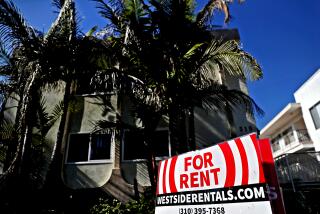L.A. Rents Rise as Silicon Valley’s Fall
- Share via
A lot of renters in Los Angeles are now paying more than apartment dwellers in Silicon Valley, according to a major survey released Wednesday.
The average monthly rent at larger complexes in the L.A. area was $1,326 in the second quarter, up $22 from the last quarter and nearly $80 more than a year earlier, according to RealFacts, a Novato, Calif., research firm that tracks data for properties with 100 or more units.
By contrast, the average rent in the San Jose area, the heart of Silicon Valley, fell to $1,308 for the quarter, down $43 from the first quarter and off $128 from a year earlier. The numbers are based on a survey of 479 properties in L.A. and 416 in San Jose.
The difference is that Silicon Valley is still reeling from the tech crash, whereas greater Los Angeles, although not exactly an economic dynamo, is benefiting from a diverse economy, ever-growing population and tight apartment supply.
“The market is hot, hot,” said Mark Verge, owner of Westside Rentals Connection, one of the region’s largest apartment listing agencies. “The perception is there’s lots of jobs here, the weather’s fine, and so we have tenants moving in from all over the country. The phones ring off the hook all day long.”
In fact, among major metro areas in the West tracked by RealFacts, Los Angeles showed the biggest dollar gain in average rent over the quarter, and was second only to the Inland Empire in the percentage increase.
Based on the survey of larger apartments, Los Angeles is more expensive than Orange County, where the average rent was $1,258 in the second quarter. The average was $924 in the Inland Empire and $1,158 in San Diego.
Only San Francisco renters, who pay an average of $1,554 a month, spend more on housing than those in Los Angeles, according to the study.
The boost in Southern California isn’t being found in many other Western cities, a difference that industry experts attribute to the region’s growing population and an economy that has withstood the technology bust.
RealFacts Chief Executive Caroline Latham said a limited apartment supply also has helped push up rents in Southern California, because what little construction is being done still won’t satisfy demand.
“One of the reasons landlords can keep raising rents is because there’s not enough units to go around,” she said.
For Maged Guirguis, who owns about 20 apartment buildings on the Westside, lower-priced apartments are showing the strongest growth. Units that cost $1,000 or less a month have risen 10% over last year, while luxury apartments have dropped as much as 15% during the same time, he said.
“Overall, we have very few vacancies,” said Guirguis, who manages 700 units. “Once people find something they tend to stay put for a while, even if the rent goes up a little.”
*
(BEGIN TEXT OF INFOBOX)
How the West was rented
Among major metropolitan areas in the West, the Inland Empire and the Los Angeles area showed the biggest increases in apartment rents in the second quarter. San Jose, the heart of the Silicon Valley, showed a decline.
Average rents and percentage change:
*--* Average Percentage Occupancy rent* change from rate Area (2nd quarter) 1st quarter (2nd quarter) Inland Empire $924 +2.3% 95.2% Las Vegas $739 -0.5 92.8% Los Angeles $1,326 +1.7 94.5% Orange County $1,258 +1.2 95.2% Phoenix $714 +0.5 90.5% Sacramento $885 +0.8 93.6% San Diego $1,158 +0.6 93.8% San Francisco $1,554 -0.6 93.6% San Jose $1,308 -3.2 93.2% Seattle $861 +0.8 92.6%
*--*
*Data for apartment complexes with 100 or more units
Source: RealFacts
More to Read
Inside the business of entertainment
The Wide Shot brings you news, analysis and insights on everything from streaming wars to production — and what it all means for the future.
You may occasionally receive promotional content from the Los Angeles Times.









